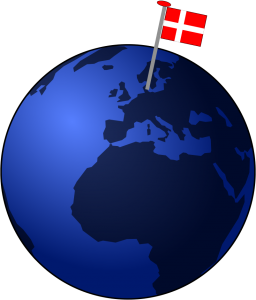Danish in the World Posted by Bjørn A. Bojesen on Feb 16, 2012 in Uncategorized
 If people had been blogging in the year 900 AD, you might very well have been reading this on gennemsigtig.kom/dansk (gennemsigtig is the Danish word for ’transparent’, from gennem ’through’ + sigt ’view’ + –ig ’-y’). The Vikings ruled the waves, and most of eastern England was a Danish colony. Admitted, the Danish spoken in Danelagen (the Danelaw) wasn’t quite like the modern language… (And web addresses would have been written in runic letters anyway… Let’s get back to 2012!)
If people had been blogging in the year 900 AD, you might very well have been reading this on gennemsigtig.kom/dansk (gennemsigtig is the Danish word for ’transparent’, from gennem ’through’ + sigt ’view’ + –ig ’-y’). The Vikings ruled the waves, and most of eastern England was a Danish colony. Admitted, the Danish spoken in Danelagen (the Danelaw) wasn’t quite like the modern language… (And web addresses would have been written in runic letters anyway… Let’s get back to 2012!)
In my experience, most people are proud of their languages: Italians love Italian, Norwegians love Norwegian, and so on. That’s not the way it works in Denmark. Whatever linguistic pride people carry with them inside, they rarely broadcast it. Bragging about your language is very un-Danish – and besides, your fellow Danes might suspect you of being a narrow-minded, racist nationalist! Instead, many people make sure to spice up their language with English bits and pieces. That is a Danish way of saying: I’m open and modern and do care about the rest of the world!
What is often overlooked, though, is that Danish is indeed an international language! Obviously, the best place to practice your Danish skills would be Denmark, where dansk is spoken by about 5.5 million persons (placing Danish in the Top 150 of the World’s most widely spoken languages). You might also want to bring your dictionary and your Transparent Language course with you to:
• Tyskland (Germany, in German: Deutschland). There are about 50.000 German citizens who consider themselves Danish. Most of them live in Sydslesvig (Southern Schleswig, in German: Südschleswig or just Schleswig) just south of the Danish border. For historical reasons the area has been in both Danish and German hands, and there is a minority on both sides of the border (Germans in Denmark and Danes in Germany). Many of the German Danes conserve their Danish language and customs. They have their own newspapers, shops and bilingual public schools.
• Grønland (Greenland, in Greenlandic: Kalaallit Nunaat). The 55.000 Greenlanders are reaching new levels of independence each year, but the world’s largest island is still a part of Rigsfællesskabet (the Danish ”Commonwealth”, literally ’The Community of the Kingdom’). The arctic country is officially bilingual, and you can get along in Danish in most – but not all – places. A considerable portion of the population is made up by Danish immigrants.
• Færøerne (the Faroe Islands, in Faroese: Føroyar). This small island group between Scotland and Iceland is also a part of Rigsfællesskabet (with Queen Margrethe as sovereign). The 45.000 inhabitants speak Faroese, but Danish is understood and spoken by everyone. I was there in 2007, and didn’t meet a single person who didn’t speak perfect Danish! In fact, it might be the perfect place for beginners, as Faroese Danish is pronounced with much greater clarity than Danish Danish!
• Island (Iceland, in Icelandic: Ísland). Iceland became fully independent from Denmark in 1944, but Danish is still taught in every public school – as a third language, after Icelandic and English. In this way, most Icelanders can communicate with Scandinavians without switching to English. If you arrive as a non-Scandinavian tourist in Reykjavik, though, most people will prefer to talk to you in English.
• Nordamerika (North America). In some faraway places, there are people who still speak Danish – though heavily mixed up with English. In California there is a Danish-style town called Solvang – my family was there, and told me it was more ”Danish” than anywhere in Denmark! 🙂 (Unfortunately, you won’t find a single Danish speaker in De Amerikanske Jomfruøer [the US Virgin Islands, down in the Caribbean], which the US bought from Denmark in 1917.)
• Norge (Norway), Sverige (Sweden), Ålandsøerne (the Åland Islands) and a few other places in Finland (the coastal towns where they speak Swedish). Most Norwegians, Swedes and Finland-Swedes understand some Danish – provided you speak slowly and pronounce ev-er-y sound. You may not have thought about it like that, but your Danish studies might eventually unlock the whole vast world of Scandinavia…
For the fun of it, I’d also like to add the German capital of Berlin to the list – sometimes it sure seems like you bump into a couple of jabbering Danes on every street corner!

Build vocabulary, practice pronunciation, and more with Transparent Language Online. Available anytime, anywhere, on any device.
About the Author: Bjørn A. Bojesen
I was born in Denmark, but spent large parts of my childhood and study years in Norway. I later returned to Denmark, where I finished my MA in Scandinavian Studies. Having relatives in Sweden as well, I feel very Scandinavian! I enjoy reading and travelling, and sharing stories with you! You’re always welcome to share your thoughts with me and the other readers.




Comments:
Bjørn A. Bojesen:
Have any of my readers been to Solvang, California? I’d love to hear about it!